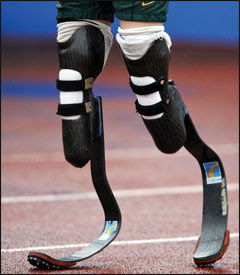
Being a physical therapist and having worked with people who have had prosthetics as well as learning about all of the energy expenditures and things, this interests me. I am sure that many of you have heard about Oscar Pistorius, the South African runner who had his legs amputated when he was a toddler. He is one of the fastest runners in the world and the debate has been over whether or not he should be allowed to run in the Beijing Olympic Games. This is a controversy because it is thought that he may have a biomechanical advantage over the able-bodied runners with his bilateral, transtibial, carbon fiber limbs .  Known as the "Blade Runner" and "the fastest man on no legs", Pistorius is the double amputee world record holder in the 100, 200 and 400 meter events. In 2007, the International Association of Athletics Federations (IAAF) amended its competition rules to ban the use of "any technical device that incorporates springs, wheels or any other element that provides a user with an advantage over another athlete not using such a device". The Federation claimed that the amendment was not specifically aimed at Pistorius. Scientists were employed by the IAAF to analyze Pistorius' track performances and after looking at the data they concluded that Pistorius gained considerable advantages over athletes without prosthetic limbs. On 14 January 2008, based on these findings, the IAAF ruled him ineligible for competitions conducted under their rules, including the 2008 Summer Olympics. Pistorius most likely will appeal the decision. The article is below as well as a few comments I have to make about it.
Known as the "Blade Runner" and "the fastest man on no legs", Pistorius is the double amputee world record holder in the 100, 200 and 400 meter events. In 2007, the International Association of Athletics Federations (IAAF) amended its competition rules to ban the use of "any technical device that incorporates springs, wheels or any other element that provides a user with an advantage over another athlete not using such a device". The Federation claimed that the amendment was not specifically aimed at Pistorius. Scientists were employed by the IAAF to analyze Pistorius' track performances and after looking at the data they concluded that Pistorius gained considerable advantages over athletes without prosthetic limbs. On 14 January 2008, based on these findings, the IAAF ruled him ineligible for competitions conducted under their rules, including the 2008 Summer Olympics. Pistorius most likely will appeal the decision. The article is below as well as a few comments I have to make about it.
Oscar Pistorius - Independent Scientific study concludes that cheetah prosthetics offer clear mechanical advantages
Monday 14 January 2008
Monte Carlo - The IAAF has received the results of an independent scientific study carried out by Professor Peter Brüggemann at the German Sport University in Cologne. This study made a biomechanical and physiological analysis of long sprint running by a double transtibial amputee athlete Oscar Pistorius (RSA) using “cheetah” prosthetics, and also compared this athlete with five able-bodied athletes who are capable of similar levels of performance at 400m.
The tests, which took place on Monday 12 and Tuesday 13 November in the Institute of Biomechanics and Orthopaedics, were initiated by the IAAF with the approval and participation of Oscar in order to see whether the prosthetics used by him should be considered as technical aids which give him an advantage over other athletes not using them, in contravention of IAAF competition rule 144.2.*
The objective results of this study are that:
- Pistorius was able to run with his prosthetic blades at the same speed as the able-bodied sprinters with about 25% less energy expenditure. As soon as a given speed is reached, running with the prosthetics needs less additional energy than running with natural limbs.
- Once the physiological potential of Oscar Pistorius and the able-bodied control athletes had been estimated, using three different methods, it is clear that Pistorius’ potential was not higher than that of the controls, even though their performance results were similar.
- The biomechanical analysis demonstrated major differences in the sprint mechanics used by a below-knee amputee using prosthetics when compared to athletes with natural legs. The maximum vertical ground reaction forces and the vertical impulses are different in a highly significant way and the amount of energy return of the prosthetic blade have never been reported for a human muscle driven ankle joint in sprint running.
- The positive work, or returned energy, from the prosthetic blade is close to three times higher than with the human ankle joint in maximum sprinting.
- The energy loss in the prosthetic blade was measured at 9.3% during the stance phase while the average energy loss in the ankle joint of the able bodied control athletes was measured at 41.4%. This means that the mechanical advantage of the blade in relation to the healthy ankle joint of an able bodied athlete is higher than 30%.
It is evident that an athlete using the Cheetah prosthetic is able to run at the same speed as able bodied athletes with lower energy consumption. Running with prosthetic blades leads to less vertical motion combined with less mechanical work for lifting the body. As well as this, the energy loss in the blade is significantly lower than in the human ankle joints in sprinting at maximum speed. An athlete using this prosthetic blade has a demonstrable mechanical advantage (more than 30%) when compared to someone not using the blade.
IAAF Council has been able to review the full report and has decided that the prosthetic blades known as “cheetahs” should be considered as technical aids in clear contravention of IAAF Rule 144.2. As a result, Oscar Pistorius is not eligible to compete in competitions organised under IAAF Rules.
Note for editors concerning test procedures and parameters:
- Analysis was carried out by a team of more than 10 scientists, including staff from the physiology laboratory of Professor J. Mester (Institute of Training Science and Sport Informatics).
- 12 high speed cameras (250 frames per second) were used to record 3D kinematics, with another 4 high speed cameras to observe sagittal plane motion
- Force platforms were used to record ground reaction forces and point of force application
- Athletes ran the 400m test with a K4 mask to record max VO2. VO2 testing was also carried out in the laboratory (Wingate and Ramp Test) on static bicycles. Blood lactate records were taken regularly
- A 3D scanner was used to record body mass and anthropometric measures of all the control athletes
- The prosthetics were also subjected to material testing
* IAAF Rule 144.2 extract
Relates to the use of" technical aids" during competition
This rule prohibits:
(e) Use of any technical device that incorporates springs, wheels or any other element that provides the user with an advantage over another athlete not using such a device.
IAAF
A few comments:
•It seems to me that the prosthetic company would have been better off naming the legs something slow so that they didn't sound so fast, but what do I know.
•In this article they didn't touch on the fact that a single below-the-knee (BTK) amputee increases their energy expenditure in walking as compared to an able-bodied person and if you are a bilateral BTK amputee you have an even greater energy expenditure. This is different than the energy that is gained or lost from the material in the prosthesis itself. VO2 testing on a bicycle won't give you energy expenditure when walking or running.
•Also, note that this study was done in response to the IAAF's request. That is similar to a drug company paying for a study to be done on their drug. The IAAF seems to be trying to protect their other athletes as they have been against him participating in the Olympics from the beginning.
Now I am not saying that if he has a true biomechanical advantage that he should be allowed to participate but I am saying that this particular study does not convince me this is the case.
Videos are coming...
Friday Funny 2441: Parenting Funnies
8 months ago


3 comments:
Maybe I'm oversimplifying this, but aren't they just saying that BTK amputees run a lot differently than able-bodied athletes? Isn't that a no brainer?
I could be wrong, but aren't those prosthetics built to make them run faster, not try to imitate the running of able-bodied athletes? All this test does is support that the prosthetic designers did what they were probably aiming to do.
There is a reason that amputees have separate competitions. Not worse or easier, just different. So who cares if amputees can run faster than your average olympic sprinter?
I'm really anxious to see how this turns out.
Interesting.
My only concern is this, when are they going to make a cool looking running shoe size 15 EEEE? I mean COME ON! I like my NB 767 but I would really like to try Newtons. Opps, I'm sorry I have no comment about biomechanical advantage.
Post a Comment